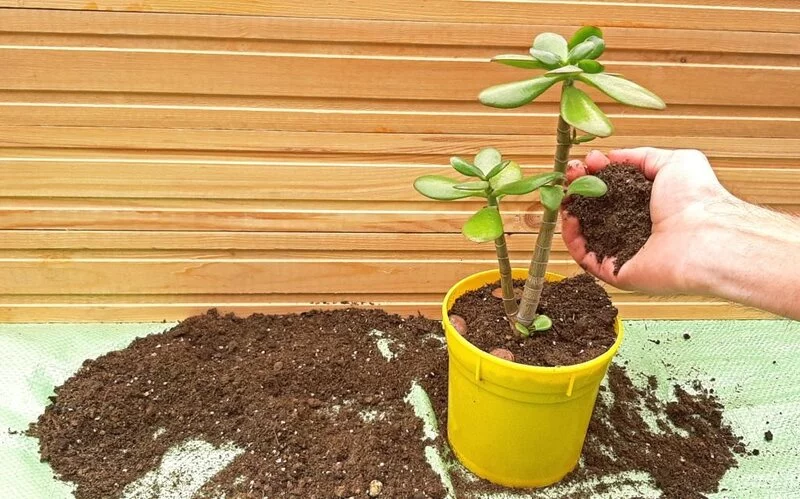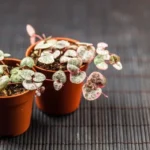Welcome to your guide to repotting jade plants! These little guys are known for their thick, lush leaves and their easy-care nature, making them a beloved addition to many homes. But there comes a time in every jade plant’s life when it outgrows its pot, and that’s when it’s time for you to step in. Don’t worry, though, we’ve got you covered. In this article, we’ll walk you through everything you need to know about when and how to repot your jade plant.
- 100% NATURAL: Special soilless blend for the plant also known as “friendship plant”, “money plant” or “silver dollar plant”
- USES: For planting or repotting Jade Plants and other indoor / outdoor succulents
- Benefits: Organic humus, coarse, drainage, aeration, and nutrient retention
- Ingredients: Coconut coir, pine bark, worm castings, horticultural charcoal, and horticultural perlite
- Size: 8 quarts (enough for a big 12-inch pot)
Knowing When to Repot Your Jade Plant
Repotting is like moving house for a plant. It can be stressful, so we want to make sure it’s necessary before we begin. You might be wondering, “How do I know if my jade plant needs a new home?” Well, here are some signs:
- Overcrowded Roots: If you notice roots popping out of the drainage holes or growing on the surface of the soil, it’s a clear sign your jade plant might be feeling a little cramped.
- Slowed Growth or Wilting: While jade plants are generally slow-growing, if you notice a significant slowdown or wilting, it might be time to give your plant more space.
- Top-Heavy Plant: Jade plants love to spread their leaves. If your plant is tipping over because of its top-heaviness, it needs a larger, more stable pot to support its growth.
Remember, jade plants typically need repotting every 2-3 years. However, it’s best to look out for these signs rather than repotting on a strict schedule. Your plant will tell you when it’s ready!
- Dimensions: Large pot: 7 Dia X 6 H inches; Medium pot – 5.5 Dia X 4.5 H; Small pot – 4 Dia X 3.5H. Great white ceramic plant pot for your larger succulents all the way down to a smaller one you need to re-pot, while not being too small.
- Yesland plant pots set of 3 with different sizes are allowed to hold more plants. Ranging from small to large sizes, this versatile set of planters can be used to display succulents, flowers, cacti, or a wide range of other home decor.
- Every ceramic planter comes with a drainage hole in the bottom. The attached saucer helps to minimize water run-off and collect excess water.
- These flower pots are created with the sturdy ceramic which is made of the kaolin, durable, not easily broken.
- Beautiful and stylish, minimalist-stylefor beautiful tabletop displays that brighten up your home. Ideal for decorating your windowsill, desktop, kitchen, bathroom, office and bedroom.This is the great choice for Mother’s Day, Housewarming gift and wedding gift.
Preparing for Repotting
You wouldn’t move house without packing first, right? Similarly, before you repot your jade plant, you’ll need to gather a few things. Here’s your packing list:
- A New Pot: Choose a pot that’s one or two sizes larger than the current one. Jade plants like to be cozy, but they also need room to grow. And don’t forget drainage holes – jade plants hate having wet feet!
- Potting Soil: Go for a well-draining, succulent or cactus mix. These plants are desert natives, after all. If you’re feeling adventurous, you can make your own mix using one part perlite, one part coarse sand, and two parts potting soil.
- Gloves and Trowel: To protect your hands and help with the repotting process.
Once you’ve gathered your supplies, you’re ready for the exciting part – the repotting!
The Repotting Process
Repotting a jade plant is like giving it a new lease on life. It might seem daunting, but don’t worry, we’ll guide you through it:
- Remove the Jade Plant: First, gently tip the plant on its side and ease it out of the pot. Try to get it out with its roots intact. If it’s being stubborn, you might need to give the pot a couple of taps.
- Clean the Roots: Once it’s out, gently shake off any old soil from the roots. This is also a good time to trim off any damaged or rotting roots.
- Prepare the New Pot: Place a layer of fresh potting soil in the bottom of the new pot.
- Repot the Jade Plant: Now place your jade plant in the new pot. The top of its root ball should be just below the rim of the pot. Fill in around the plant with more potting soil, pressing down gently to remove any air pockets.
- Rest the Plant: Give your jade plant a few days to rest and acclimate to its new pot before you water it. This allows any damaged roots time to heal and reduces the risk of root rot.
Voila! You’ve successfully repotted your jade plant! But wait, we’re not done yet. Let’s talk about aftercare.
Jade Plant Aftercare
You’ve done the hard part—repotting. But to ensure your jade plant thrives in its new home, follow these aftercare steps:
- Watering: Wait for a few days before watering your repotted jade plant. This rest period allows any disturbed roots to recover. When you do water, soak the soil thoroughly, but ensure it drains well—remember, no soggy feet!
- Sunlight: Place your jade plant in a spot with bright, indirect light. They love the sun, but too much direct light right after repotting might stress them out.
- Fertilizer: After about a month, when your jade plant has settled into its new home, you can begin a regular feeding schedule. Use a diluted, balanced fertilizer and feed every 3-4 weeks during the growing season.
- Instantly feeds succulent plants, including cacti
- For all cacti, jade, aloe and other popular succulents
- Feeds instantly
- Able to apply directly to the soil or can mix with water
- Feed every 2 weeks
Conclusion
Congratulations! You are now a pro at repotting jade plants. With your help, your jade plant can continue to grow and thrive, filling your space with greenery and good vibes. Remember, plant care is about more than keeping your plant alive; it’s about helping it to thrive. And you’ve done just that by giving your jade plant the space it needs to grow. So, enjoy this lush, leafy addition to your indoor jungle. You’ve earned it!






